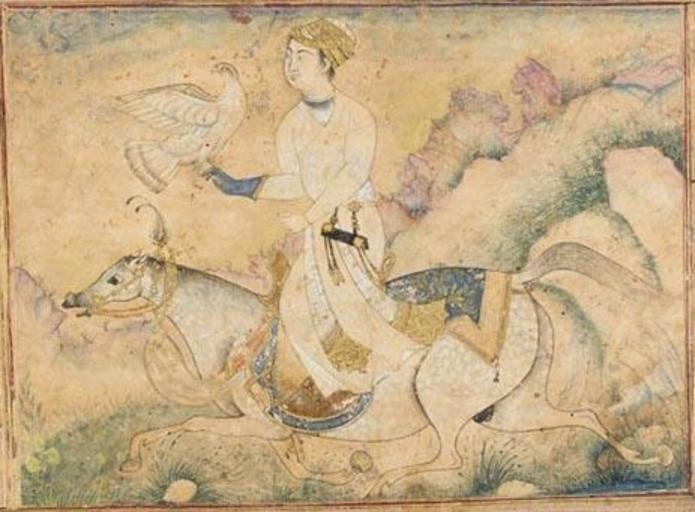MAKE A MEME
View Large Image

| View Original: | A_Deccani_courtier_who_may_or_may_not_be_the_king_himself,_c.1600.jpg (463x341) | |||
| Download: | Original | Medium | Small | Thumb |
| Courtesy of: | commons.wikimedia.org | More Like This | ||
| Keywords: A Deccani courtier who may or may not be the king himself, c.1600.jpg pen and gouache heightened with gold on paper laid down on stout paper with borders incorporating panels of nasta'liq calligraphy central panel with a courtier on horseback carrying a hawk on his right hand and riding through a rocky landscape CATALOGUE NOTE This impressive portrait is strikingly similar to a portrait from the Leningrad Album hailed by Zebrowski as the most poetic Bijapuri portrait to have survived depicting the Deccani ruler Ibrahim Adil Shah II r 1579-1627 hawking Zebrowski 1983 pl ix p 89 The central figure with his outstretched arm blue gauntlet and snowy eagle cantering through a rocky landscape on a piebald horse is closely comparable in both subject matter and style to this example Other features exhibited in the present lot are comparable to the Leningrad album page and suggest that it too is a royal portrait the facial type with pursed lips aquiline nose and rounded cheeks distinctly recalls portraits of Sultan Ibrahim Adil Shah II see Zebrowski 1983 pl vi p 54 and pl 50 p 75 Akbar's contemporary Sultan Ibrahim II was an active patron of the arts who encouraged all manner of artists whether poets musicians or painters in their creative endeavours A contemporary poem by the sultan's poet laureate Zhuhuri describes his support of the arts in fulsome terms no thorn in the path of Art ever pierced a man's foot but he picked up gardens of flowers from Ibrahim's favour and in nothing was the excellence of Art hidden but his discernment openly fell in love with it Zebrowski 1983 p 68 This praise is not just the flattery of a courtier documentary evidence supports these claims through other means Poets painters and calligraphers are all recorded as distinguished members of the sultan's inner circle and the explicit mention of the painter's name Farrukh Hussain indicates the esteem in which he was held The Deccani and Mughal artistic traditions are deeply tied to one another both stylistically and in practice For example the nascent Deccani school of the 1560s and 70s owes much to the Mughal atelier in its representation of body mass and movement whilst during the following century Mughal artists are known to have specialized in painting in a Deccani style and to have copied Deccani works However the Deccani school developed an earthier more direct expressiveness absent in the restraint and formality of the Mughal type Deccani masters plunge their portrait subjects into semi darkness through dramatic shading and sculpt dream-like landscapes from fantastic palettes that recall the earlier traditions of Bijapur Whilst this portrait does not exhibit all the distinctive characteristics of the Deccani school and the later portrait of Adil Shah II hawking on horseback it is possible to suggest that this painting was produced shortly after the artist Farrukh Beg moved from the Mughal court in 1600 importing a cooler palette with the Safavid aesthetic that he expounded ~ 1600 http //www columbia edu/itc/mealac/pritchett/00routesdata/1500_1599/bijapur/ibrahimadilshah2/ibrahimadilshah2 html STYLE OF FARRUKH BEG BIJAPUR DECCAN INDIA PD-Art Uploaded with UploadWizard Ibrahim Adil Shah II Paintings of men of Karnataka 1600s paintings from India 1600 in Karnataka People with horses in art of India Falconry in art Falconry in India Hunting in art of India | ||||